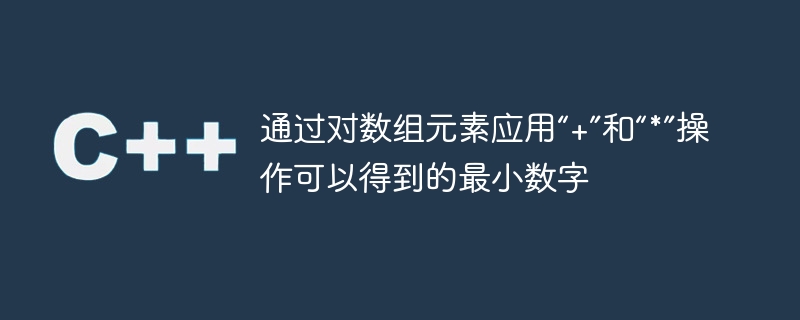
我们给出了一个长度为“N”的数组,其中包含一些正整数。另外,我们给出了长度为“N-1”的字符串,仅包含“*”和“+”字符,其中“*”是乘法运算符,“+”是加法运算符。我们要求对数组元素进行算术运算,以获得最小的正整数值。
array = [1,2,3], str = “*+”
5
它是 ((1*2) + 3) 的结果值。
array = [3, 3, 3, 3], str = ‘*++’
15
它执行 array[0]*array[1],等于 9,并表示结果 1。之后,它将 result1 与 array[2] 相加,等于 12,并表示为 result2。接下来,它将 result2 添加到数组 [3],等于 15。
array = [1, 3, 5, 6], str = “**+”
21
它是 ((1*3*5) + 6) 的结果值。
我们将使用位掩码来解决此方法中的问题。
每当我们有两个选择时,我们就可以使用位掩码。在这里,我们要求以任意顺序应用算术运算,但我们需要在给定字符串的乘法和算术运算之间进行选择
因此,位掩码使我们能够获得所有可能的方式来排列两个算术运算符。之后,我们可以对每路进行算术运算,并检查结果是否为最小值。
让我们通过示例输入来清楚上述逻辑。在下面的示例中,数组 = [1. 3, 5, 6],字符串 = “*++”。
这里,字符串长度为3。因此,我们总共可以有8(2^3)个位掩码,分别是000, 001, 010, 100, 110, 101, 011, 111。
现在,如果我们假设“1”为“*”,“0”为“+”运算符,我们就可以得到字符串中给出的算术运算符的所有排列。
然而,只有当“1”的总数等于“*”运算符的数量,并且“0”的数量等于“+”运算符的数量时,我们才应该使用任何排列。
用户应按照以下算法来实现上述方法。
步骤 1 - 定义“totalMul”变量并将其初始化为零,以存储字符串中乘法算术运算符的总数。
步骤 2 - 使用 for 循环迭代给定的字符串。如果当前字符等于“*”,则将“totalMul”变量的值增加 1。
步骤 3 - 使用for循环获取X等于字符串长度时的所有可能位掩码。这里,'len'是数组长度,'len - 1'是字符串长度。
步骤 4 - 定义“setBitCount”变量来存储当前掩码中设置的位数。另外,定义“order”列表来存储算术运算的当前顺序。
步骤 5 - 在 for 循环中,使用另一个 for 循环来获取当前掩码中设置位的总数 (‘1’)。左移1位j,与I进行&运算,判断第j位是否置位。
步骤 6 - 如果当前位是设置位,则增加“setBitCount”变量的值并将“*”推入顺序向量中;否则,将“+”推入顺序向量中。
第7步 - 如果setBitCount的值等于totalMul的值相同,则意味着我们可以使用当前掩码来安排算术运算;否则,我们将进入下一次迭代。
第 8 步 - 在 if 语句中,使用“deque”数据结构定义“currentQueue”来存储数组元素。
步骤 9 - 遍历 'order' 列表。如果当前字符是 '*',则弹出队列中的最后一个元素,并将其与当前数组索引处的元素相乘。
第 10 步 - 如果“orders”列表中的当前字符为“+”,则将当前数组元素推送到“currentQueue”中。
第 11 步 - 使用 while 循环从“currentQueue”中弹出所有元素并对所有元素求和。
第 12 步 - 使用 min() 函数从“minimum”和“sum”变量中获取最小值。
#include <bits/stdc++.h>
using namespace std;
// Function to get the minimum number by applying mathematical operations in any order.
int getMinimumSum(int array[], int len, string str){
// to store a total number of multiplication operators in the string.
int totalMul = 0;
for (int i = 0; i < (int)str.size(); i++){
// increment totalMul if the current character is '*'
if (str[i] == '*')
totalMul += 1;
}
// store maximum number value in the result.
int minimum = 1000000;
// Iterate over all the possible masks and find the minimum value by applying arithmetic operations.
for (int i = 0; i < (1 << (len - 1)); i++){
// to store the number of bits set in the mask.
int setBitCount = 0;
// to store the order of the operators.
vector<char> order;
// finding a total number of mask bits in the current mask 'i'. If the current bit is set to bit, push '*' in the order vector; else, push '+'.
for (int j = 0; j < len - 1; j++){
if ((1 << j) & (i)){
setBitCount += 1;
order.push_back('*');
} else {
order.push_back('+');
}
}
// if the set bit count is equal to the total number of multiplication operators, then only apply the operations.
if (setBitCount == totalMul){
// queue to store the current elements.
deque<int> currentQueue;
// push the first element in the queue.
currentQueue.push_back(array[0]);
for (int j = 0; j < len - 1; j++) {
// get the current operator from the order vector.
if (order[j] == '*'){
// if the current operator is '*', multiply the last element in the queue with the next element in the array.
int temp = currentQueue.back();
currentQueue.pop_back();
temp = temp * array[j + 1];
// push a new value
currentQueue.push_back(temp);
} else {
// if current operator is '+', then push the next element in the array in the queue.
currentQueue.push_back(array[j + 1]);
}
}
int sum = 0;
// Add all the elements in the queue.
while (currentQueue.size() > 0){
int temp = currentQueue.front();
sum += temp;
currentQueue.pop_front();
}
// get the minimum value.
minimum = min(minimum, sum);
}
}
return minimum;
}
int main(){
int array[] = {1, 3, 5, 6};
string str = "*++";
int len = sizeof(array) / sizeof(array[0]);
cout << "Minimum number value can be achieved is : " << getMinimumSum(array, len, str);
return 0;
}
Minimum number value can be achieved is : 14
时间复杂度 - O(2N-1*N),其中 N 是数组的长度。当我们迭代所有位掩码时,在其中,我们使用 for 循环来计算当前掩码中设置位的总数,它是 O(2N-1*N)。
空间复杂度 − O(N),因为我们使用列表来存储算术运算符的顺序。
以上是通过对数组元素应用'+”和'*”操作可以得到的最小数字的详细内容。更多信息请关注PHP中文网其他相关文章!
